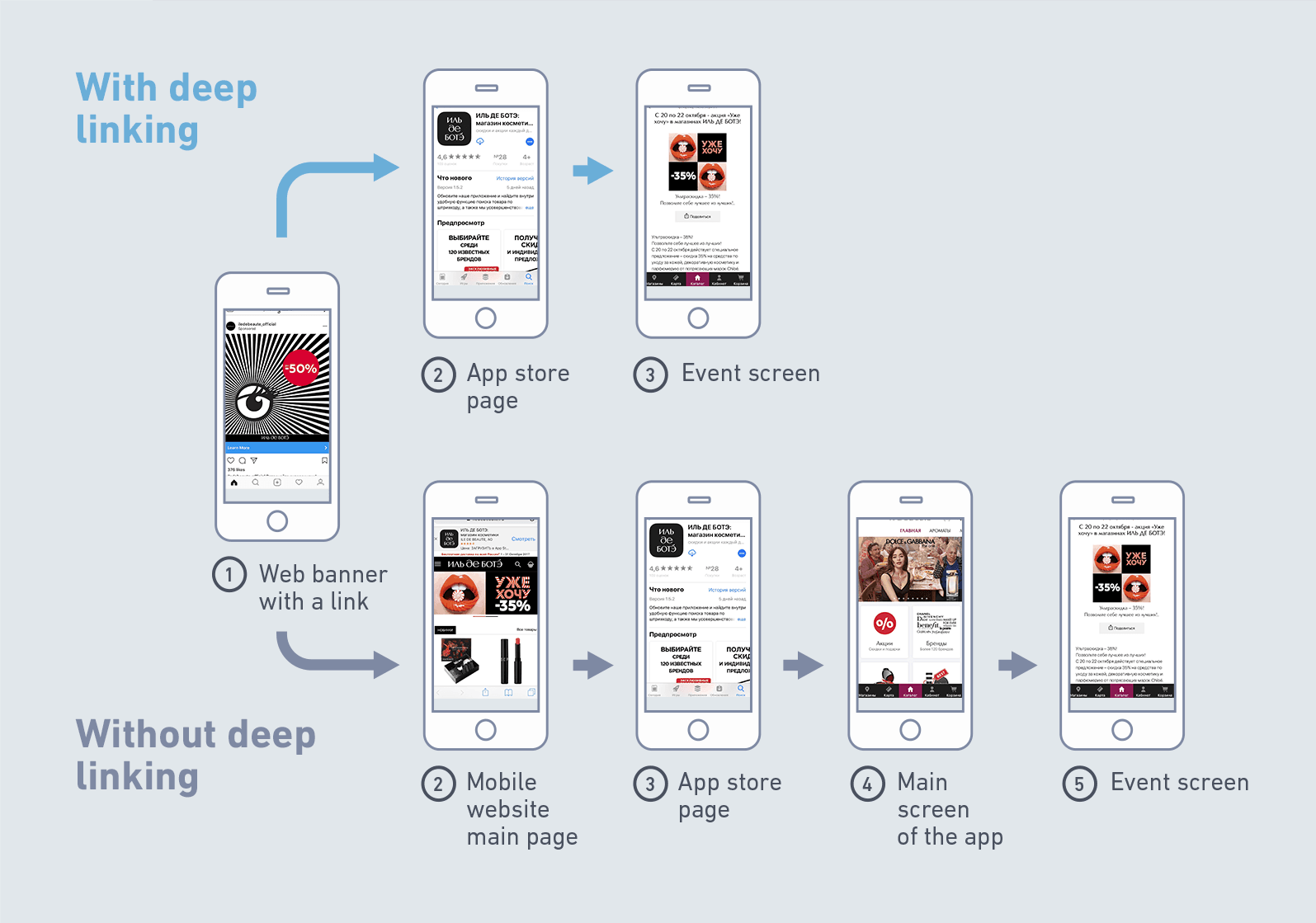Deep Linking: What You Need To Know + Examples!
Ever clicked a link and landed exactly where you needed to be, bypassing endless scrolling? That's the power of "deep linking," a technique reshaping how we navigate the digital world and a crucial strategy for anyone serious about online presence and user experience.
At its core, a deep link isn't just your average URL. Think of it as a guided missile, precisely targeting a specific page or section within a website or app. It’s a direct pathway, cutting through the noise and delivering users to the content they crave, instantaneously. This contrasts sharply with a standard hyperlink, which simply points to a general webpage, leaving the user to fend for themselves in the labyrinthine structure of the site. The impact? Enhanced user experience, increased engagement, and a potential boost to SEO.
Here's a breakdown of the key aspects of deep linking:
| Aspect | Description |
|---|---|
| Definition | A hyperlink that takes a user directly to a specific page or location within a website or mobile app, bypassing the homepage or initial landing page. |
| Purpose | To improve user experience by providing a direct route to desired content, increase app engagement and conversion rates, and enhance marketing campaign effectiveness. |
| Types |
|
| Benefits |
|
| Implementation | Involves using specific code and platforms to create and manage deep links. Platforms like Branch, Firebase Dynamic Links, and AppsFlyer offer tools and services for deep linking implementation. WordPress also provides plugins and methods to incorporate deep links. |
| Considerations |
|
| Example Use Cases |
|
| Further Resources | Example Deep Linking Guide (This is a placeholder link; replace with a real resource) |
Deep linking is not a one-size-fits-all solution, but understanding its nuances is essential for crafting a robust online strategy. The debate surrounding deep linking often touches upon the rights of content creators and the practices of search engines. Some argue that content owners, by not explicitly disallowing deep linking through a `robots.txt` file, implicitly consent to the practice. Others contend that content owners may simply be unaware of the technicalities involved or may not possess the resources to manage such configurations.
Regardless of the debate, the technical mechanics are fairly straightforward. Deep linking functions by embedding a specific hyperlink within digital content – be it a social media post, an email campaign, or a digital advertisement. This hyperlink then bypasses the typical navigational steps, taking the user directly to the desired functionality or section within the app or website. This is particularly valuable in the mobile app space where platforms like Branch, Firebase Dynamic Links, and AppsFlyer offer specialized tools for creating and managing these links, particularly within ecosystems like WordPress, where dedicated plugins exist to simplify the integration of deep linking capabilities.
However, the real power of deep linking lies in its potential to elevate user engagement and streamline the user journey. Consider the scenario of a social media ad promoting a specific product on an e-commerce platform. Without deep linking, a user clicking on the ad would likely be directed to the homepage of the e-commerce site, requiring them to then search for the advertised product. Deep linking eliminates this unnecessary step, taking the user directly to the product page, increasing the likelihood of a purchase. In the context of mobile apps, deep links can direct users to specific features, onboard them seamlessly, and even personalize the app experience based on the referring link.
The impact of deep linking extends beyond mere convenience; it can significantly influence SEO strategy. While not a direct ranking factor, deep linking can indirectly improve SEO by increasing user engagement metrics such as time spent on site or app, pages per session, and conversion rates. A better user experience translates to happier users, and search engines favor websites and apps that provide a seamless and satisfying user experience. By guiding users precisely to the content they are seeking, deep linking can contribute to a more positive user perception of the brand, fostering loyalty and encouraging repeat visits.
But like any powerful tool, deep linking requires careful planning and implementation. Developers must ensure platform compatibility, guaranteeing that deep links function seamlessly across different operating systems (iOS and Android) and devices. They must also consider user privacy, particularly when deep links are used to transmit data. Transparency and adherence to data protection regulations are paramount. Furthermore, it is essential to track the performance of deep links to measure their effectiveness and optimize campaigns. Analyzing metrics such as click-through rates, conversion rates, and user engagement can provide valuable insights into the success of deep linking strategies.
The rise of deepfake technology presents an interesting juxtaposition. While deep linking aims to provide a more direct and authentic user experience, deepfakes leverage AI to create fabricated content that can be incredibly misleading. The recent surge in deepfake videos targeting celebrities like Rashmika Mandanna, Priyanka Chopra Jonas, Alia Bhatt, Kajol, and Nora Fatehi serves as a stark reminder of the potential for misuse of advanced technologies. These manipulated videos, often involving the digital alteration of faces or bodies, can have serious consequences, including reputational damage and emotional distress. The contrast between the utility of deep linking and the dangers of deepfakes underscores the importance of responsible technology development and ethical considerations.
In the realm of mobile marketing, deep linking is becoming increasingly crucial for SMS campaigns. By embedding deep links within SMS messages, brands can drive app sessions, promote specific features, and encourage user engagement. This is particularly effective for re-engaging dormant users or guiding new users through the initial onboarding process. When executed effectively, SMS deep linking can result in significant improvements in app retention rates and customer lifetime value.
The term "deep linking" should not be confused with the culinary term frequently used in the Southern United States. Companies like Deep South Choice Products, founded in the spring of 2005, specialize in hot links and smoked sausages, offering products under the Deep South brand and H & H's Cajun Delite brand. While the term overlaps, the context is entirely different. In the digital world, deep linking refers to a technological innovation that enhances user experience and drives engagement, while in the culinary world, it refers to a specific type of food product.
As the digital landscape continues to evolve, deep linking is poised to play an increasingly important role in shaping online experiences. Its ability to streamline user journeys, enhance app engagement, and improve marketing effectiveness makes it a valuable tool for businesses of all sizes. By understanding the principles of deep linking and implementing it strategically, organizations can unlock new opportunities for growth and success in the ever-competitive digital world. The key is to approach it with a user-centric mindset, focusing on providing a seamless and valuable experience for every user who clicks on a deep link.
For WordPress users, specifically, integrating deep links can be relatively straightforward. Several plugins are designed to simplify the process of creating deep links, enabling seamless navigation within a WordPress site and integration with mobile apps. If you have a mobile app associated with your WordPress site, consider leveraging platforms like Branch, Firebase Dynamic Links, or AppsFlyer to create deep links that can open your app to specific content, bridging the gap between web and mobile experiences. This cross-platform integration is becoming increasingly important as users interact with content across a variety of devices and channels.
In conclusion, deep linking is a powerful tool for enhancing user experience, driving engagement, and improving marketing effectiveness. By providing a direct path to specific content within websites and apps, deep links can streamline user journeys, increase conversion rates, and foster customer loyalty. As the digital landscape continues to evolve, deep linking is poised to play an increasingly important role in shaping online experiences, making it an essential skill for marketers, developers, and website owners alike. The ability to seamlessly connect users with the information they seek is a competitive advantage in today's fast-paced digital world, and deep linking provides a powerful mechanism for achieving this goal.
While some search queries may not yield the expected results ("We did not find results for: Check spelling or type a new query. Please refresh to try again."), the concept of deep linking itself is well-defined and widely applicable. Its implementation requires careful planning and attention to detail, but the potential benefits make it a worthwhile investment for any organization seeking to enhance its online presence and improve user engagement. From e-commerce platforms to content apps, deep linking has the power to transform the way users interact with digital content, creating a more seamless and satisfying experience for all.
In essence, the question "Why I need to know how to use deep linking?" is answered by understanding its ability to improve user experience and, ultimately, business outcomes. Mastering the creation and implementation of deep links is an investment in the future of your online presence. The journey from a simple hyperlink to a strategically crafted deep link is a journey towards greater engagement, increased conversions, and a more satisfied user base. It is a journey well worth undertaking in today's competitive digital landscape. So, embrace the power of deep linking and unlock the potential it holds for your website or app.
Remember, "Great journeys lead to ROX" - Return on Experience. And deep linking is a significant step in creating those great journeys for your users.

Unveiling Deephotlink The Gateway To Stunning Visuals

Deep Hot Link The Ultimate Guide To Mastering Digital Connections

Exploring Deephot.link Unraveling The Power Of Digital Link Management